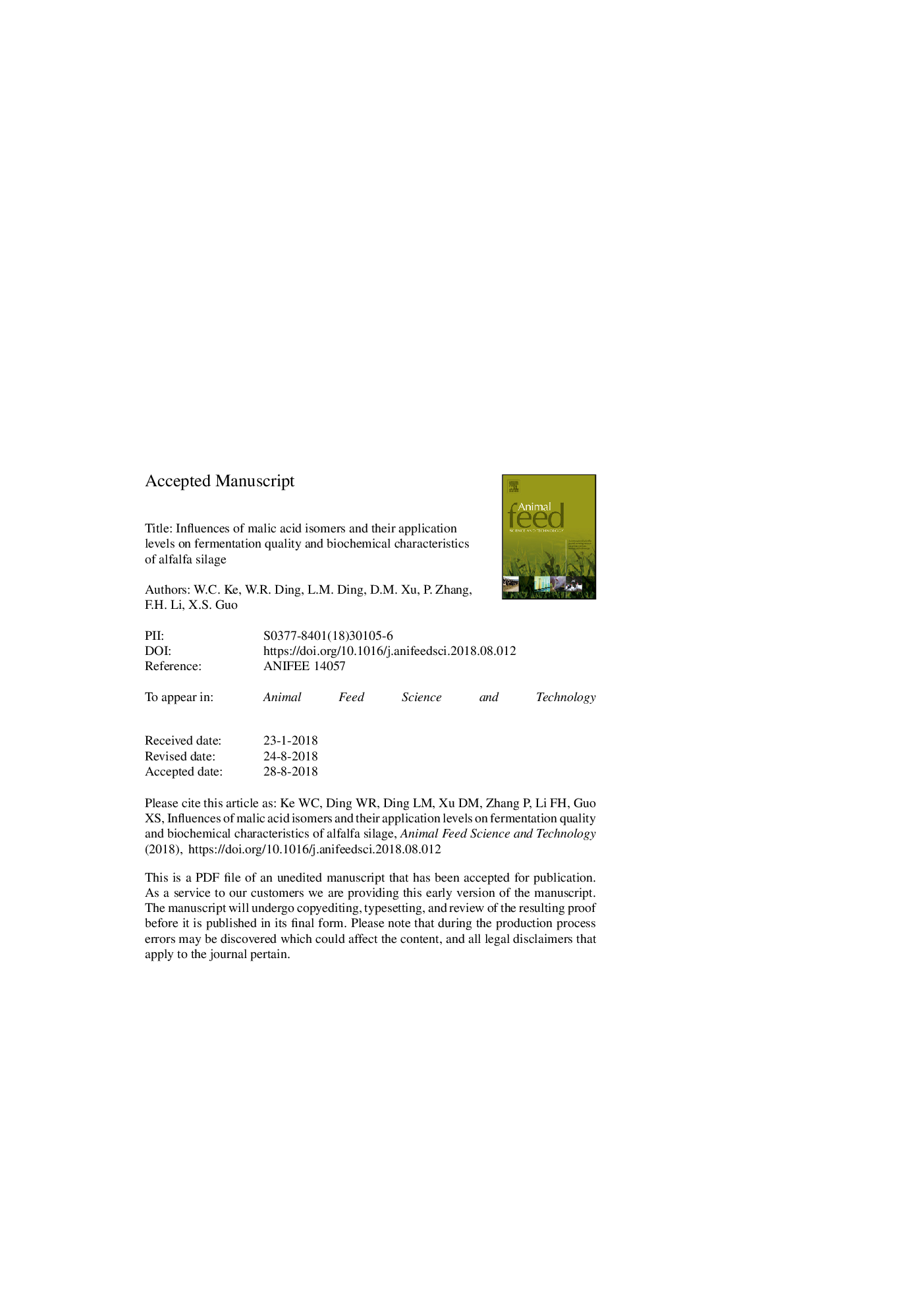| Article ID | Journal | Published Year | Pages | File Type |
|---|---|---|---|---|
| 8973669 | Animal Feed Science and Technology | 2018 | 39 Pages |
Abstract
The study was conducted to investigate the effects of different malic acid (MA) isomers (D-MA, L-MA and DL-MA) and their application levels (0, 0.2, 0.6 and 1% of fresh weight, FW) on the fermentation and biochemical characteristics of alfalfa silage, as well as on the degradation of these MA isomers in silage. Alfalfa was harvested at early bloom stage, and after wilting to approximately 35% dry matter (DM), the chopped forages were ensiled in vacuum-sealed polyethylene bags containing 200-230âg wilted forage for 60 d, with 3 replications for each treatment. Silage pH decreased with the increase of the application level of MA. Lactic acid in silage also increased when the application level of MA ranged from 0.2% to 0.6%. However, a decline in lactic acid was observed when the application level of MA reached 1% (FW). On average silage treated with DL-MA had greater lactic acid concentration compared to D-MA or L-MA treated silages. Treatment with MA lowered non-protein nitrogen (NPN) concentration in ensiled forage as application level of the MA increased. In comparison with the control silage, inclusion of MA at ensiling effectively decreased the proportion of saturated fatty acids (SFA) in total fatty acid, whereas it markedly increased the proportion of α-linolenic acid and polyunsaturated fatty acids (PUFA), and silages treated with DL-MA had greater PUFA and lower SFA. After 60 d of ensiling, the concentration of MA decreased from 22.4âg/kg DM in fresh alfalfa to 6âg/kg DM in silage. On average the greatest percent of MA degraded was observed in L-MA followed by DL-MA, and the averaged residues of MA in D-MA, L-MA and DL-MA-treated silages were 19.8, 12.6, and 16.1âg/kg DM, respectively. Although the amount of degraded MA in ensiled alfalfa increased with the elevated application levels, the percent of MA degraded decreased constantly. Overall, silage microbes used more of L-MA or DL- MA than D-MA, and application of 0.6% DL-MA at the ensiling of alfalfa effectively improved silage fermentation, limited proteolysis, lipolysis and biohydrogenation in ensiled alfalfa.
Keywords
MUFAADFdl-Malic acidNPNaNDFSFATCANH3-NWSCl-Malic acidLABAmmonia Nitrogentrichloroacetic acidMalic acidFatty acidsaturated fatty acidPolyunsaturated fatty acidmonounsaturated fatty acidPUFAacid detergent fiber expressed inclusive of residual ashLactic acid bacteriaalfalfa silageFAMENeutral detergent fiber assayed with a heat stable amylase and expressed inclusive of residual ashLipolysisdry matterfatty acid methyl estersNon-protein nitrogenProteolysiscrude proteinWater soluble carbohydrateshigh performance liquid chromatographyHPLCFermentation quality
Related Topics
Life Sciences
Agricultural and Biological Sciences
Animal Science and Zoology
Authors
W.C. Ke, W.R. Ding, L.M. Ding, D.M. Xu, P. Zhang, F.H. Li, X.S. Guo,
